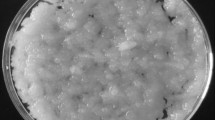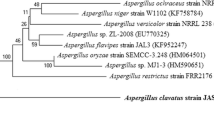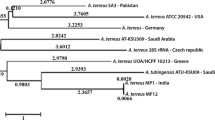Abstract
Low-density polyethylene (LDPE) possesses various applications in several industries owing to its durability, low-cost, and many mechano-thermal properties. Unfortunately, LDPE waste creates an environmental threat. The level of biodegradation of black LDPE sheets with fungi isolated from different landfills sites in Sharqiyah Governorate, Egypt, was evaluated. LDPE sheets, the only source of carbon, along with minimal salt medium were incubated on a rotary shaker at 30 °C and 120 rpm for 16 weeks. Aspergillus carbonarius MH 856457.1 and A. fumigatus MF 276893 confirmed to be good candidates for LDPE biodegradation. A mixed culture of two strains showed the excellent weight loss% of sheets as compared to single isolate. Further efforts to improve the degrading capacity through physical and chemical treatments were performed. The biodegradation was significantly stimulated by 39.1% (thermal treatment), 17.76% (HNO3 treatment), and 5.79% (Gamma-irradiation treatment). Laccases and manganese peroxidases activities were assayed. LDPE biodegradation was analyzed by scanning electronic microscopy (SEM), Fourier transform infrared spectroscopy (FTIR), X-ray diffraction (XRD), and gas chromatography–mass spectrometry (GC–MS). FTIR spectra showed the appearance of new functional groups assigned to hydrocarbon biodegradation and confirmed the role of manganese peroxidase in process. The changes in the FTIR spectra of the mixed culture biomass before and after the biodegradation (Δ73 cm−1) and the surface changes in the biodegraded LDPE (as indicated from SEM) confirmed the depolymerization of LDPE. From GC–MS analysis, the plasticizers bis(2-ethylhexyl) phthalate, Diisssctyl phthalate, 1,2-benzenedicarboxylic acid diisooctyl ester, and tributyl acetylcitrate completely biodegraded. Moreover, several antioxidants, antimicrobial, and anticancer compounds, and methyl esters of fatty acids were produced.















Similar content being viewed by others
References
A’lvarez-Barragán, J., Domínguez-Malfavón, L., Vargas-Suárez, M., González-Hernández, R., Aguilar-Osorio, G., & Loza-Tavera, H. (2016). Biodegradative activities of selected environmental fungi on a polyester polyurethane varnish and polyether polyurethane foams. Applied and Environmental Microbiology, 82(17), 5225–5235.
Abdel-Shafy, H. I., & Mansour, M. S. M. (2018). Microbial degradation of hydrocarbons in the environment: An Overview. In V. Kumar, M. Kumar, & R. Prasad (Eds.), Microbial action on hydrocarbons (pp. 353–386). Singapore: Springer.
Abraham, J., Ghosh, E., Mukherjee, P., & Gajendiran, A. (2017). Microbial degradation of low density polyethylene. Environmental Progress & Sustainable Energy, 36(1), 147–154.
Altschul, S. F., Gish, W., Miller, W., Myers, E. W., & Lipmanl, D. J. (1990). Basic local alignment search tool. Journal of Molecular Biology, 215, 403–410.
Amarjit, S. (2013). Sustainability: how the cosmetics industry is greening up. New York: Wiley.
Anderson, M. J., Gull, K., & Denning, D. W. (1996). Molecular typing by random amplification of polymorphic DNA and M13 southern hybridization of related paired isolates of Aspergillus fumigatus. Journal of Clinical Microbiology, 34, 87–93.
Anwar, M. S., Negi, H., Zaidi, M. G. H., Gupta, S., & Goel, R. (2013). Biodeterioration studies of thermoplastics in nature using indigenous bacterial consortia. Brazilian Archives of Biology and Technology, 56, 475–484.
Arutchelvi, J., Sudhakar, M., Arkatkar, A., Doble, M., Bhaduri, S., & Uppara, P. V. (2008). Biodegradation of polyethylene and polypropylene. Indian Journal of Biotechnology, 7, 9–22.
Awasthi, S., Srivastava, N., Singh, T., Tiwary, D., & Mishra, P. (2017). Biodegradation of thermally treated high-density polyethylene (HDPE) by Klebsiella pneumoniae CH001. 3 Biotec, 7, 332.
Azhagumurugan, C., & Rajan, M. K. (2014). GC–MS Analysis of phytochemical constituents and nematicidal activities of leaf extract of Magilam. Mimusops elengi. World Journal of Zoology, 9(4), 239–243.
Balasubramanian, V., Natarajan, K., Hemambika, B., Ramesh, N., Sumathi, C. S., Kottaimuthu, R., et al. (2010). High-density polyethylene (HDPE)-degrading potential bacteria from marine ecosystemof Gulf of Mannar, India. Letters in Applied Microbiology, 51(2), 205–211.
Balderas-López, J., Alfaro-Romero, A., Monroy, A., López-Villafranco, M. E., Rivero-Cruz, J., & Navarrete, A. (2013). Toxic rather than neuropharmacological effect of Ternstroemia sylvatica fruits and identification of 28-O-[β-l-6- rhamnopyranosyl]-R1-barrigenol as a new compound with toxic effects in mice. Pharmaceutical Biology, 51(11), 1451–1458.
Barnett, H. L., & Hunter, B. B. (1994). Illustrated Genera of imperfect fungi. Minneapolis, MN: Burgess publishing Co.
Barreca, D., Gattuso, D., & lagana, G., Leuzzi, U. & Belloco, E. . (2016). C- and O-glycosyl flavonoids in Sanguinello and Tarocco blood orange (Citrus sinensis (L.) Osbeck) juice: Identification and influence on antioxidant properties and acetylcholinesterase activity. Food Chemistry, 196, 619–627.
Berk, Z. (2018). Food packaging. In Z. Berk (Ed.), Food process engineering and technology (3rd ed., pp. 625–641). Amasterdam: Elsevier.
Boll, M., Geiger, R., Junghare, M., & Schink, B. (2020). Microbial degradation of phthalates: Biochemistry and environmental implications. Minireview. Environmental Microbiology Reports, 12(1), 3–15.
Booth, C. (1971). The genus fusarium. Kew, Surrey: Commonwealth Mycological Institute.
Bove, K. E., Heubi, J. E., Balistreri, W. F., & Setchell, K. D. (2004). Bile acid synthetic defects and liver disease: A comprehensive review. Pediatric and Developmental Pathology, 7, 315–334.
Brunner, I., Fischer, M., Rüthi, J., Stierli, B., & Frey, B. (2018). Ability of fungi isolated from plastic debris floating in the shoreline of a lake to degrade plastics. PLoS ONE, 13(8), 0202047. https://doi.org/10.1371/journal.pone.0202047.
Cabarcos, P., Tabernero, M. J., Otero, J. L., Míguez, M., Bermejo, A. M., Martello, S., et al. (2014). Quantification of fatty acid ethyl esters (FAEE) and ethyl glucuronide (EtG) in meconium for detection of alcohol abuse during pregnancy: Correlation study between both biomarkers. Journal of Pharmaceutical and Biomedical Analysis, 100, 74–78.
Chakraborty, J., & Das, S. (2017). Application of spectroscopic techniques for monitoring microbial diversity and bioremediation. Applied Spectroscopy Reviews, 52(1), 1–38.
Chaudhary, A. K., & Vijayakumar, P. (2020). Effect of chemical treatment on biological degradation of high-density polyethylene (HDPE). Environment, Development and Sustainability, 22, 1093–1104.
Cushnie, T. P., & Lamb, A. (2011). Recent advances in understanding the antibacterial properties of flavonoids. International Journal of Antimicrobial Agents, 38(2), 99–107.
Das, M., Kumar, S., & Das, J. (2018). Fungal-mediated deterioration and biodegradation study of low-density polyethylene (LDPE) isolated from municipal dump yard in Chennai, India. Energy, Ecology and Environment, 3(4), 229–236.
Das, M. P., & Kumar, S. (2015). An approach to low-density polyethylene biodegradation by Bacillus amyloliquefaciens. 3 Biotech, 5, 81–86.
Dutia, P. (2004). Ethyl acetate: A techno-commercial profile. Chemical Weekly, 6, 179–186.
Edem, D. O. (2009). Vitamin A: A review. Asian Journal of Chemical Nutrition, 1(1), 65–82.
Eliza, J., Daisy, P., & Ignacimuthu, S. (2010). Antioxidant activity of costunolide and eremanthin isolated from Costus speciosus (Koen ex. Retz) Sm. Chemico-Biological Interactions, 188(3), 467–672.
Eliza, J., Daisy, P., Ignacimuthu, S., & Duraipandiyan, V. (2009). Antidiabetic and antilipidemic effect of eremanthin from Costus speciosus (Koen.)Sm., in STZ-induced diabetic rats. Chemico-Biological Interactions, 182(1), 67–72.
Esmaeili, A., Pourbabaee, A. A., Alikhani, H. A., Shabani, F., & Esmaeili, E. (2013). Biodegradation of Low-Density Polyethylene (LDPE) by mixed culture of Lysinibacillus xylanilyticus and Aspergillus niger in soil. PLoS ONE, 8(9), e71720. https://doi.org/10.1371/journal.pone.0071720.
Fahlbusch, K., Hammerschmidt, F., Panten, J., Pickenhagen, W., Schatkowski, D., Bauer, K., Garbe, D., & Surburg, H. (2007). Flavors and fragrances. In Ullmann's encyclopedia of industrial chemistry (7th edn., pp. 74–78). New York: Wiley.
Fleury-Brégeot, N., Oehlrich, D., Rombouts, F., & Molander, G. A. (2013). Suzuki-Miyaura cross-coupling of potassium dioxolanylethyltrifluoroborate and aryl/heteroaryl chlorides. Organic Letters, 15(7), 1536–1539.
Ghosh, S. K., Pal, S., & Ray, S. (2013). Study of microbes having potentiality for biodegradation of plastics. Environmental and Science Pollution Research, 20, 4339–4355.
Gnanavel, G., JayaValli, M. V. P., & Thirumarimurugan, M. (2013). Degradation of plastics waste using microbes. Elixir Chemical Engineering, 54, 12212–12214.
González-Márquez, A., Ahuactzin-Pérez, M., & Sánchez, C. (2015). Lentinula edodes grown on Di(2-ethylhexyl) phthalate-containing media: Mycelial growth and enzyme activities. BioResources, 10(4), 7898–7906.
Gu, J. D., Li, J., & Wang, Y. (2005). Biochemical pathway and degradation of phthalate ester isomers by bacteria. Water Science & Technology, 52, 241–248.
Hasan, F., Shah, A. A., Hammeed, A., & Ahmed, S. (2007). Synergistic effect of photo and chemical treatment on the rate of biodegradation of low density polyethylene by Fusarium sp. AF4. Journal of Applied Polymer Science, 105, 1466–1470.
Iiyoshi, Y., Tsutsumi, Y., & Nishida, T. (1998). Polyethylene degradation by lignin-degrading fungi and manganese peroxidase. Journal of Wood Science, 44, 222–229.
Kalaivani, C. S., Sathish, S. S., Janakiraman, N., & Johnson, M. (2012). GC–MS studies on Andrographis paniculata (Burm.f.) Wall. ex Nees—A medicinally important plant. International Journal of Medicinal and Aromatic Plants, 2, 69–74.
Kitch, M. A., & Pitt, J. I. (1992). A laboratory guide to the common Aspergillus species and their teleomorphs. Sydney: CSIRO.
Koshti, R., Mehta, L., & Samarth, N. (2018). Biological recycling of polyethylene terephthalate: A mini-review. Journal of Polymers and the Environment, 26, 3520–3529.
Kull, K. (2010). Ecosystems are made of semiosic bonds: Consortia, umwelten, biophony and ecological codes. Biosemiotics, 3(3), 347–357.
Lowry, O. H., Rosebrough, N. J., Farr, A. L., & Randall, R. J. (1951). Protein measurement with the Folin phenol reagent. Journal of Biological Chemistry, 193(1), 265–275.
Luo, G., & Mitchell, T. G. (2002). Rapid Identification of pathogenic fungi directly from cultures by using multiplex PCR. Journal of Clinical Microbiology, 40(8), 2860–2865.
Ma, J., Xu, R., Lu, Y., Ren, D., & Lu, J. (2018). Composition, antimicrobial and antioxidant activity of supercritical fluid extract of Elsholtzia ciliate. Journal of Essential Oil Bearing Plants, 21(2), 556–562.
Maarse, H. (1991). Number and level of volatile compounds in fruits. In H. Maarse (Ed.), Volatile compounds in foods and beverages (pp. 27–30). Boca Raton: CRC Press.
Mahalakshmi, V., Siddiq, A., & Andrew, S. N. (2012). Analysis of polyethylene degrading potentials of microorganisms isolated from compost soil. International Journal of Pharmaceutical & Biological Archives, 3, 1190–1196.
Mahalakshmi, V., & Siddiq, S. A. (2015). Enhanced biodegradation of polyethylene by development of a consortium. Pelagia Research Library, 6(4), 183–189.
Markofsky, S. B. (2000). Nitro compounds aliphatic. In: Ulmann's Encyclopedia of industrial chemistry. Wiley, Weinheim.
Meechaona, R., Sengpracha, W., Banditpuritat, J., Kawaree, R., & Phutdhawong, W. (2007). Fatty acid content and antioxidant activity of Thai bananas. Maejo International Journal of Scienceand Technology, 1(2), 222–228.
Mohrig, J. R., Noring, H. C., & Schatz, P. F. (2006). Laboratory techniques in organic chemistry. New York: W. H. Freeman.
Montazer, Z., Habibi-Najafi, M. B., Mohebbi, M., et al. (2018). Microbial degradation of UV-pretreated low-density polyethylene films by novel polyethylene-degrading bacteria isolated from plastic-dump soil. Journal of Polymers and Environment, 26, 3613–3625.
Morancho, J. M., Ramis, X., Fernndez, X., Cadenato, A., Salla, J. M., Vallés, A., et al. (2006). Calorimetric and thermogravimetric studies of UV-irradiated polypropylene/starch-based materials aged in soil. Polymer Degradation and Stability, 91(1), 44–51.
Muhonja, C. N., Makonde, H., Magoma, G., & Imbuga, M. (2018). Biodegradability of polyethylene by bacteria and fungi from Dandora dumpsite Nairobi-Kenya. PLoS ONE, 13(7), e0198446.
Musuc, A. M., Badea-Doni, M., Jecu, L., Rusu, A., & Popa, V. T. (2013). FTIR, XRD, and DSC analysis of the rosemary extract effect on polyethylene structure and biodegradability. Journal of Thermal Analysis and Calorimetry, 114(1), 169–177.
National Research Council (U.S.) Subcommittee on spacecraft maximum allowable concentrations. (1996). Spacecraft maximum allowable concentrations for selected airborne contaminants. Washington: National Academies Press.
Nowak, B., Pajak, J., Drozd-Bratkowicz, M., & Rymarz, G. (2011). Microorganisms participating in the biodegradation of modifed polyethylene films in different soils under laboratory conditions. International Biodeterioriation & Biodegradation, 65(6), 757–767.
Ogunbayo, A. O., Olanipekun, O. O. & Adamu, I. A. (2019). Preliminary studies on the microbial degradation of plastic waste using Aspergillus niger and Pseudomonas sp. Journal of Environmental Protection, 10, 625–631.
Oh, J. H., Jeong, Y. J., Koo, H. J., Park, D. W., Kang, S. C., Khoa, H. V., et al. (2014). Antimicrobial activities against periodontopathic bacteria of Pittosporum tobira and its active compound. Molecules, 19(3), 3607–3616.
Ojha, N., Pradhan, N., Singh, S., Barla, A., Khatua, P., Rai, V., & Bose, S. (2017). Evaluation of HDPE and LDPE degradation by fungus, implemented by statistical optimization. Scientific Reports, 7, 39515. https://doi.org/10.1038/srep39515.
Papinutti, L., & Martínez, M. J. (2006). Production and characterization of laccase and manganese peroxidase from the ligninolytic fungus Fomes sclerodermeus. Journal of Chemical Technology and Biotechnology, 81(6), 1064–1070.
Parte, S., Sirisha, V. L., & D’Souza, J. S. (2017). Biotechnological applications of marine enzymes from algae, bacteria, fungi, and sponges. Advanced Food and Nutrition Research, 80, 75–106.
Pathak, V. M., & Navneet, . (2017). Review on the current status of polymer degradation: a microbial approach. Bioresource Bioprocess, 4, 15.
Parthipan, B., Suky, M. G. T., & Mohan, V. R. (2015). GC–MS Analysis of phytocomponents in Pleiospermiumalatum (Wall. ex Wight & Arn.) Swingle, (Rutaceae). Journal of Pharmacognosy and Phytochemistry, 4(1), 216–222.
Peixoto, J., Silva, L. P., & Kruger, R. H. (2017). Brazilian Cerrado soil reveals an untapped microbial potential for unpretreated polyethylene biodegradation. Journal of Hazardous Materials, 324(Pt B), 634–644.
Pitt, J. I. (1986). Properties of the ideal fungal enumeration medium. In A. D. King, J. I. Pitt, L. R. Beuchat, & J. Corry (Eds.), Methods for the mycological Examination of food (pp. 63–65). New York: Plenum.
Pramila, R., & Ramesh, K. V. (2015). Potential biodegradation of low density polyethylene (LDPE) by Acinetobacter baumannii. African Journal of Bacteriology Research, 7(3), 24–28.
Prossnitz, E. R., & Barton, M. (2014). Estrogen biology: new insights into GPER function and clinical opportunities. (review). Molecular and Cellular Endocrinology, 389(1–2), 71–83.
Rangel-Sanchez, G., Castro-Mercado, E., & Garcia-Pineda, E. (2014). Avocado roots treated with salicylic acid produce phenol-2,4-bis (1,1-dimethylethyl), a compound with antifungal activity. Journal of Plant Physiology, 171, 189–198.
Reddy, M. M., Gupta, R. K., Gupta, R. K., Bhattacharya, S. N., & Parthasarathy, R. (2008). Abiotic oxidation studies of oxo-biodegradable polyethylene. Journal of Polymer and the Environment, 16(1), 27–34.
Restrepo-Flórez, J., Bassi, A., & Thompson, M. (2014). Microbial degradation and deterioration of polyethylene—A review. International Biodeterioration and Biodegradation, 88, 83–90.
Ricciotti, E., & FitzGerald, G. (2011). Prostaglandins and Inflammation. Arteriosclerosis, Thrombosis, and Vascular Biology, 31(5), 986–1000.
Ritchie, H. (2018). Plastic Pollution. Published online at Our World In Data.org. Retrieved from: https://ourworldindata.org/plastic-pollution.
Robyt, J. F. (2012). Essentials of carbohydrate chemistry. Berlin: Springer.
Russo, G. L., Russo, M., Spagnuolo, C., Tedesco, I., Bilotto, S., Iannitti, R., & Palumbo, R. (2014). Quercetin: a pleiotropic kinase inhibitor against cancer. A review. Cancer Treatment Research, 159, 185–205.
Rusyn, I., & Corton, J. C. (2012). Mechanistic considerations for human relevance of cancer hazard of di(2-ethylhexyl) phthalate. Mutation Research/Review in Mutation Research, 750(2), 141–158.
Sand, W. (2003). Microbial life in geothermal waters. Geothermics, 32(4), 655–667.
Sen, S. K., & Raut, S. (2015). Microbial degradation of low density polyethylene (LDPE): A review. Journal of Environmental Chemical Engineering, 3, 462–473.
Sheel, A., & Pant, D., et al. (2018). Microbial Depolymerization book chapter. In S. J. Varjani (Ed.), Waste bioremediation, energy, environment, and sustainability (pp. 61–103). Berlin: Springer.
Sheik, S., Chandrashekar, K. R., Swaroo, K., & Somashekarappa, H. M. (2015). Biodegradation of gamma irradiated low density polyethylene and polypropylene by endophytic fungi. International Biodeterioration & Biodegradation, 105, 21–29.
Sivan, A. (2011). New Perspectives in plastic biodegradation. Current Opinion in Biotechnology, 22, 422–426.
Skariyachan, S., Megha, M., Kini, M. N., Mukund, K. M., Rizvi, A., & Vasis, K. (2015). Selection and screening of microbial consortia for efficient and ecofriendly degradation of plastic garbage collected from urban and rural areas of Bangalore, India. Environ Monit Assess, 2015(187), 4174–4187.
Sowmya, H. V., Ramalingappa, B., Nayanashree, G., Thippeswamy, B., & Krishnappa, M. (2015). Polyethylene degradation by fungal consortium. International Journal of Environmental Research, 9(3), 823–830.
Tamura, K., Stecher, G., Peterson, D., Filipski, A., & Kumar, S. (2013). MEGA6: molecular evolutionary genetics analysis version 6.0. Molecular Biology and Evolution, 30, 2725–2729.
Thompson, J. D., Higgins, D. G., & Gibson, T. J. (1994). CLUSTAL W: improving the sensitivity of progressive multiple sequence alignment through sequence weighting, position-specific gap penalties and weight matrix choice. Nucleic Acids Research, 22(22), 4673–4680.
Tribedi, P., & Sil, A. K. (2013). Low-density polyethylene degradation by pseudomonas sp. AKS2 biofilm. Environmental Science Pollution Research, 20(6), 4146–4153.
Vesoula, J., & Cocka, I. E. (2011). An Examination of the Medicinal potential of Pittosporum phylliraeoides: Toxicity, antibacterial and antifungal activities. Pharmacognosy Communications, 1(2), 8–17.
Viikari, L., Suurnäkki, A., Grönqvist, S, Raaska, L. & Ragauskas, A. (2009). Forest products: Biotechnology in pulp and paper processing. In Encyclopedia of microbiology (3rd edn., pp 80–94).
Wang, H., Chen, S. J., & Zhang, J. (2009). Surface treatment of LLDPE and LDPE blends by nitric acid, sulfuric acid, and chromic acid etching. Colloid & Polymer Science, 287(5), 541–548.
Wei, L. S., Wee, W., Siong, J. Y., & Fitrya, D. (2011). Characterization of antimicrobial, antioxidant, anticancer properties and chemical composition of Malaysian Andrographis paniculata leaf extract. Pharmacology, 2, 996–1002.
Wilkes, R. A., & Aristilde, L. (2017). Degradation and metabolism of synthetic plastics and associated products by Pseudomonas sp.: Capabilities and challenges. Journal of Applied Microbiology, 123(3), 582–593.
Yu, F. R., Lian, X. Z., Guo, H. Y., McGuire, P. M., Li, R. D., Wang, R., & Yu, F. H. (2005). Isolation and characterization of methyl esters and derivatives from Euphorbia kansui (Euphorbiaceae) and their inhibitory effects on the human SGC-7901 cells. Journal of Pharmacy Science, 8, 528–535.
Author information
Authors and Affiliations
Corresponding author
Additional information
Publisher's Note
Springer Nature remains neutral with regard to jurisdictional claims in published maps and institutional affiliations.
Rights and permissions
About this article
Cite this article
El-Sayed, M.T., Rabie, G.H. & Hamed, E.A. Biodegradation of low-density polyethylene (LDPE) using the mixed culture of Aspergillus carbonarius and A. fumigates. Environ Dev Sustain 23, 14556–14584 (2021). https://doi.org/10.1007/s10668-021-01258-7
Received:
Accepted:
Published:
Issue Date:
DOI: https://doi.org/10.1007/s10668-021-01258-7




